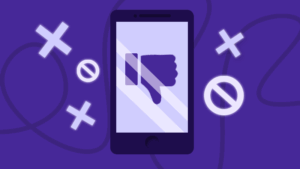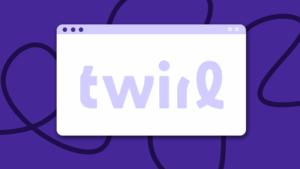14 New Cyber Monday Marketing Ideas to Boost Sales
Seasoned copywriter, promoting the Oxford comma one sentence at a time. Skilled at writing internet-friendly copy, optimizing user journeys, and educating clients on the ever-changing ways of communicating effectively. Worked with brands like Coca-Cola, Adidas, Samsung, Nord Security, and many more.
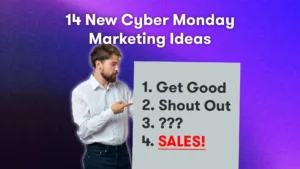
With Black Friday and Cyber Monday around the corner, you might be wondering:
“How do I take advantage of the biggest shopping spree of the year?”
We’ve curated a list of the best Cyber Monday marketing ideas to bring traffic to your online store, engage potential customers, and drive more sales.
If this sounds like your goals – keep reading.
What is Cyber Monday?
Cyber Monday is one of the biggest online shopping events of the year. It happens on the Monday after Thanksgiving and Black Friday.
Like brick-and-mortar stores offering exclusive discounts and deals on Black Friday, e-commerce stores prepare special offers for Cyber Monday.
The term Cyber Monday was born in 2005 to describe the rise of online sales on the Monday after Thanksgiving. Since then, it has grown into one of the main shopping events in the United States, gradually growing in popularity domestically and around the world.
Last year, ecommerce spending in the U.S. reached an all-time high at $12.4 billion. That’s 9.6% more than the year before.
Here’s what that means for e-commerce businesses.
Why is Cyber Monday Marketing Important?
Cyber Monday offers online businesses a unique opportunity to drive sales and revenue at the start of the holiday shopping season.
With 75% of U.S. adults shopping between Thanksgiving and Cyber Monday, a solid marketing campaign can help you reach your customers at their preferred time. It’s all about helping them do their holiday shopping with a smile.
But that’s not all.
Cyber Monday deals can help you build loyalty with existing customers or reactivate inactive customers.
And there’s some good news for small business owners. Cyber Monday deals can help you compete with more prominent brands, attract new customers, and build brand awareness.
Cyber Monday Marketing Ideas
1. Create a Cyber Monday landing page
Create a dedicated Cyber Monday landing page to help consumers understand your offers and navigate your store.
A landing page is the first page users will land on when coming from your social media ads or emails. From there, you want to guide them to your deals with clear CTAs addressing their interests and pain points.
But how do you make your landing page more effective?
Keep it simple.
Making it too busy can confuse potential customers. Instead, use white space to make different design elements pop.
The same goes for your language – use concise and punchy phrases to communicate clearly and guide your customers to purchase.
2. Reveal exclusive offers
On top of discounts, you can promote exclusive offers to provide more value and convince potential customers that this is the best time to shop.
Ulta Beauty, a chain of cosmetic stores, offered a free beauty bag with 22 samples for all online purchases over $90. So shoppers get massive discounts on Cyber Monday, plus the chance to test out various products for free.

“Buy one, get one free” is another sales offer you can apply on top of existing discounts to increase the average order value (AOV). Target hypermarkets commonly use different variations of this offer, such as “buy one, get the one half price” or “buy three, get one free,” to encourage bulk sales.
3. Create a sense of urgency
Another Cyber Monday marketing idea is to use the fear of missing out to create a sense of urgency.
You can do that by adding a countdown on your website to keep users active and discourage them from leaving your store.
Another option is to send email alerts, like the clothing brand J.Crew did, reminding customers that all offers are time-sensitive.

Take things one step further by adding competition elements to the shopping experience. Display limited stocks or launch different time-bound offers throughout the Cyber Monday 24-hour period.
4. Partner with UGC creators
Partner with user-generated content creators to bring life and authenticity to your Cyber Monday campaign.
How are UGC creators different from influencers? Brands work with influencers to tap into their existing audience. In turn, UGC creators might not have a following, and you’d hire them for their skills in creating relatable, peer-to-peer content.
Working with UGC creators is also cost-effective, allowing you to create high-quality content on a budget.
Here’s an Instagram carousel post from swimwear brand Kulani Kinis featuring different user-generated photos. Showing how real customers wear the products feels more authentic than studio-made professional photos.

5. Group products in bundles
Group similar or related products into bundles to simplify your customers’ buying process and incentivize them to spend more on your website.
Bundling allows you to increase the average dollar value of every customer order.
At the same time, bundles can eliminate excess stock or save on packing and shipping costs.
For example, beauty chain Sephora prepared several “Sephora Favorites” bundles, such as this makeup set. This bundle allows customers to buy nine bestselling products at once, saving them the time and effort of browsing and picking from different product categories.
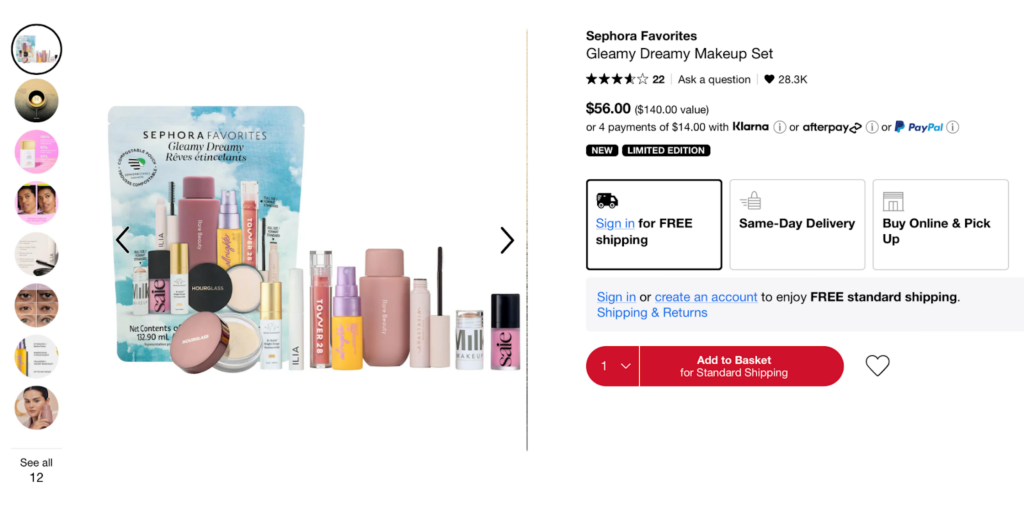
Here’s another clever tip from Sephora – show the bundle value next to the retail price. Purchasing the products from this set individually would cost $140, while the bundle retails for $56.
6. Create different gift guides
Buying gifts during the holiday season can be overwhelming, making many consumers indecisive. Curate a selection of gift guides to help them make the best choices.
British department store John Lewis launched gift guides for him and her, so customers can browse a selection of products depending on who they’re buying for.

You can also create gift guides based on interests like bookseller Barnes & Noble did by preparing a list of books they’d recommend for fiction or cooking lovers.
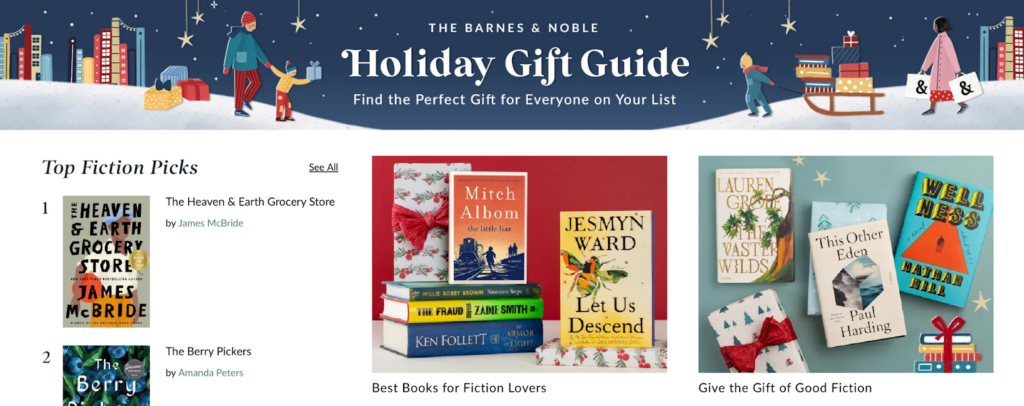
Another idea is to create gift guides based on price ranges so consumers can easily find products within their budget.
7. Upsell and cross-sell
Upselling and cross-selling are popular tactics for increasing revenue. You can use one or both to maximize sales on Cyber Monday.
Upselling is when you offer potential customers an improved version of what they’re already considering buying. Let’s say someone is looking at a pair of white sneakers on your website. Then, they get a recommendation for a similar pair with better materials and a higher price tag. It works like magic because this person is already looking to buy a pair of white sneakers.
Cross-selling is when you recommend related products to complement an order. For the customer buying white sneakers, that might be cleaning foam or a waterproofing spray. So, a shopper who wanted to buy one item now checks out with a few.

8. Offer free shipping
Let’s face it – nobody likes to pay shipping fees. By offering free shipping, you’re meeting customer expectations and encouraging them to choose your store over competitors.
The statistics are clear – free shipping is a deal breaker for 62% of online shoppers. At the same time, over 40% of consumers would complete an action to qualify for free shipping, such as signing up for a loyalty program or reaching a minimum order value.
If free shipping over a certain payment is your usual policy, you can also offer free shipping without a minimum purchase requirement. Here’s how athletic apparel retailer Lululemon did it in their Cyber Monday email.
9. Use organic and paid social media
Use Cyber Monday social media posts to promote your sales event, build engagement, and drive customers to your online store.
Lululemon used TikTok to promote some of their best products currently on sale while giving practical tips on trendy colors or how to style them.
@lululemon Prepare the cart. Get a move on our best Black Friday scores before they’re gone. #lululemonwhatsnew #blackfriday2022 #lululemonblackfriday #wemadetoomuch#greenscreen
♬ original sound – lululemon
Another idea is to tap into Cyber Monday advertising. Launch retargeting video ads to potential customers who’ve dropped off your website. Video ads are highly engaging because they stimulate different senses and draw shoppers in with visual storytelling.
10. Treat your email subscribers
Cyber Monday is a great time to re-engage customers who have been inactive for some time or reward the customers who’ve been supporting your brand. Segment your email lists and offer custom offers for each segment.
Here’s an example from Ulta Beauty, which offers email subscribers an extra $10 off when they buy online.
Identify your top-tier customers and prepare exclusive deals and bundles for them. Your top tier might be the customers who’ve passed a certain level in your loyalty program or your first 1,000 customers. Treating them for the holidays will make them feel extra special and appreciated.

11. Send cart abandonment emails
Shopping cart abandonment is one of the most common challenges to online sales. Use emails to re-engage potential buyers and guide them back to checkout.
The harsh truth is that only 3 out of 10 customers who add products to their shopping carts complete a purchase.
The reasons are many: extra costs, an unsatisfactory return policy, a complicated checkout process, a limited choice of payment methods. The list goes on.
Effective emails can help you restore some of the lost revenue.
But to achieve that, you’d need customers to open your emails. Start by drafting a catchy subject line to grab customers’ attention.
In the email body, you can include social proof to support your claims and be more persuasive.
What are the most popular types of social proof for email marketing? Think customer reviews, testimonials, user-generated content, displaying the number of recent purchases of a given product, and more.
12. Launch a Cyber Monday contest
Add a contest or contest to your Cyber Monday marketing plan to reach and engage new audiences.
You might be wondering – do contests work? And the data shows they do.
Contest emails have higher open rates (45%) and conversion rates (5.52%) than any other type of email campaign. Email is also the most preferred marketing channel for launching contests.
The key to a successful contest is to provide an enticing reward.
You can also use contests to incentivize consumers to perform specific actions, such as signing up for your newsletter or following your social media accounts. Just don’t make it too complicated.
Browse these contest examples to inspire your Cyber Monday marketing.
13. Prepare more offers for Cyber Week
Extend Cyber Monday into Cyber Week to give your customers more chances to shop on offers ahead of the holidays.
Maybe some of your customers didn’t find the time to shop during the Thanksgiving weekend. Or perhaps they’ve done their holiday shopping but are looking for more deals. You can capitalize on both by extending your offers throughout the week starting on Cyber Monday.
Prescription eyewear retailer Glasses USA prepared an exclusive offer for everyone shopping during Cyber Week – they get a $25 to $100 discount depending on their purchase value.
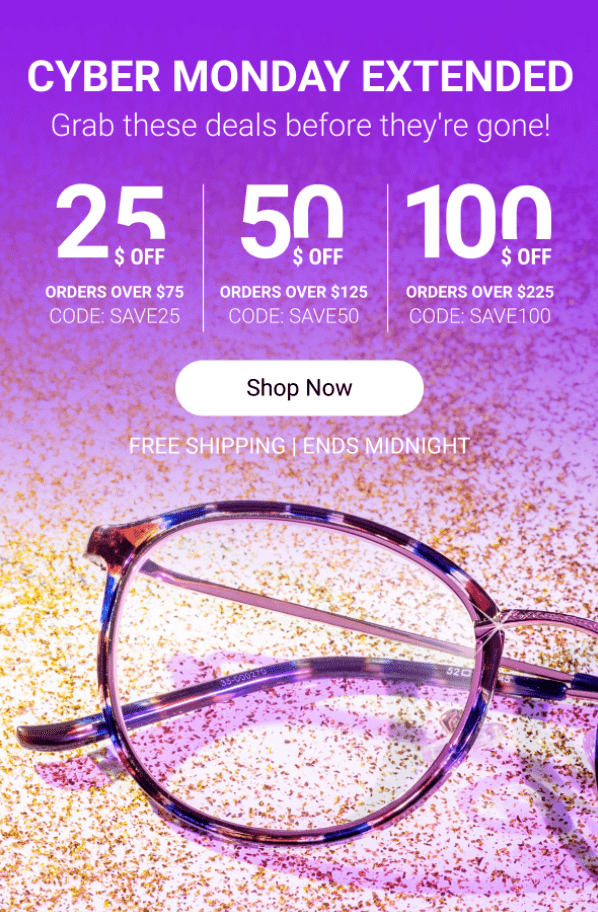
14. Offer buy now pay later payment options
Imagine your customers land in your store and find amazing deals, but when they get to the checkout, they don’t have the budget to pay for their purchases upfront. An easy way to keep your customers and meet their needs is to offer buy now, pay later (BNPL) options.
BNPL payment methods allow customers to split their purchases into interest-free installments, easing their financial burden. Some BNPL providers include PayPal, Klarna, and Afterpay.
Adding BNPL options to your website can encourage customers to place higher orders or purchase larger-ticket items.
Here’s how eyewear retailer Frames Direct advertised BNPL in their Cyber Monday email.

Seasoned copywriter, promoting the Oxford comma one sentence at a time. Skilled at writing internet-friendly copy, optimizing user journeys, and educating clients on the ever-changing ways of communicating effectively. Worked with brands like Coca-Cola, Adidas, Samsung, Nord Security, and many more.

Authentic creator videos, powered by real performance data
22,000+ brands use Billo to turn UGC into high-ROAS video ads.
The Power of Content Seeding: How to Plant Your Brand Across the Web
Content distribution has shifted — dramatically. Today, 70% of B2B [...]...
Read full article10 Common Digital Marketing Mistakes to Avoid in 2025
Digital marketing is fast, and what worked years ago might [...]...
Read full articleBest Twirl Alternatives: Which to Choose for Your Business
Twirl is one of many platforms helping brands connect with [...]...
Read full article


